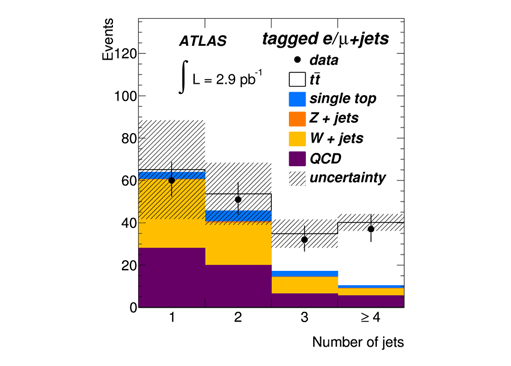
ATLAS e-News
23 February 2011
Top marks!
15 December 2010

Distribution of events with increasing numbers of jets in the events selection for top quarks pairs with a single lepton, compared to the expected distribution determined from simulation and/or data control samples. The various expected backgrounds are shown in colour. The theory prediction for top quarks, which on average have more jets than the backgrounds, are shown in white. The cross section is calculated from the events with at least 4 jets.
As the LHC sinks into its well-earned winter hibernation, one of the final papers of the year � the top cross section measurement � is the first to make use of all parts of the detector in a reconstruction. The paper was approved last week, and represents a significant milestone for the collaboration.
“We have electrons, and muons, and jets, and missing energy. And also jets defined as coming from b-quarks. So we pretty much use everything,” explains Top Working Group co-convenor Wouter Verkerke. “For that reason, it's a complicated analysis.”
It is an important analysis though, since the top background must be well understood before any precise statements can be made about other future potential LHC measurements, such as the Higgs. Not only that, says Wouter, “In many new physics scenarios we see enhanced production or modified decay in top quarks, one way or another.”
The analysis is an important test of the Standard Model as it's currently understood. “This is a general problem we have � we don't know precisely what the Standard Model looks like at LHC energies, so we have to measure that. The top quark is sort of the high-end part of that program, because it's the heaviest and has been the least measured [elsewhere].”
Being significantly more massive than the other Standard Model quarks makes the top quark harder to produce (pre-LHC, only the Tevatron had sufficiently high energy) and much shorter lived. And because they decay so quickly, top quark pairs don't form resonances, making them difficult to find.
Since it was impossible to reconstruct all the top quarks from their decay products, the analysts focussed on two channels. The first channel has a relatively clean signal with two hard leptons, but it only accounts for a small fraction of all top pair decays. The second channel with one leptonic and one hadronic decay � is more abundant but is subject to much higher background. Identification of top pairs that decay eventually to just quarks is impossible at this stage.
“So we counted events over a certain topology, where we expected top quarks to be in the sample, then we looked at control samples in data to make an estimate of all the other backgrounds we had in that sample,” says Wouter, explaining that they tried to avoid relying on detector simulation and theory as much as possible. “Of course, to translate that back to a cross section, you need a theoretical prediction to tell you what fraction of all top quark decays would have ended up in your selection.”
The two major backgrounds they had to account for were leptons and quarks coming from unrelated W boson production, and QCD multi-jet events, which can mimic leptons or can hide muons and electrons originating from top quark decays. Multi-jet backgrounds depend heavily on detector performance, so they could not be estimated ahead of time, “But if you know [from your control data sample] how often a jet fakes an electron, you can make an educated guess about how often it happens in your signal sample.”
With such a complex set of backgrounds to deal with, the top cross-section necessarily had to involve a lot of people. In fact, says Wouter, “For several of the background estimations, a number of procedures were prepared in advance because we didn't know which would work best, without detailed information on detector and reconstruction performance.”
People have been working on this analysis since March this year, doing preparatory work, defining strategy, and optimising selections, before the real analysis could begin on the three inverse picobarns of data that had been gathered by the end of August. The final note, edited by a core of six people, is a distillation of 11 internal notes whose combined author list surpasses 200.
The paper gives two separate top cross section estimates � one derived from each decay channel, and consistent with each other within the errors � as well as a more precise combined figure, “our single best value”.
“Physics-wise, we didn't run into any surprises,” Wouter reflects. “The Standard Model prediction is quite precise these days � theory gives only a seven or eight per cent uncertainty. Now we have a 30 per cent error on our value, but meanwhile there is ten times more data on tape, so that error will soon go down. In the next year we will certainly get to a point where we can start really testing the Standard Model predictions.”
 Ceri PerkinsATLAS e-News
|